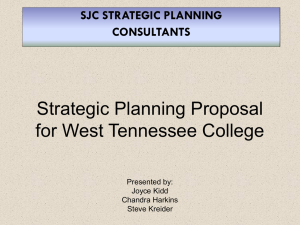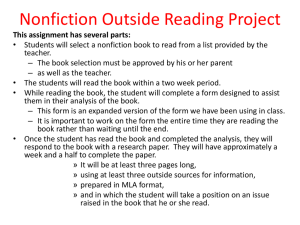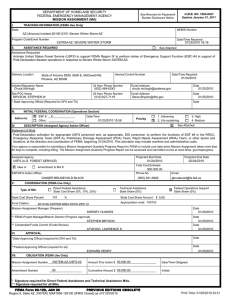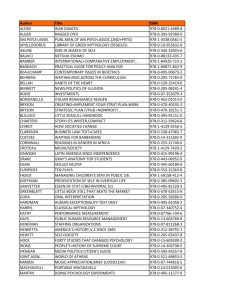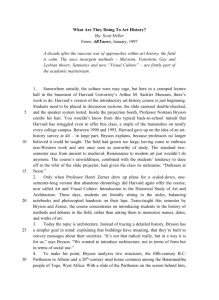A Methodology for Discerning What the Public Values: The Case... Collaborative Regional Geographic Information Systems
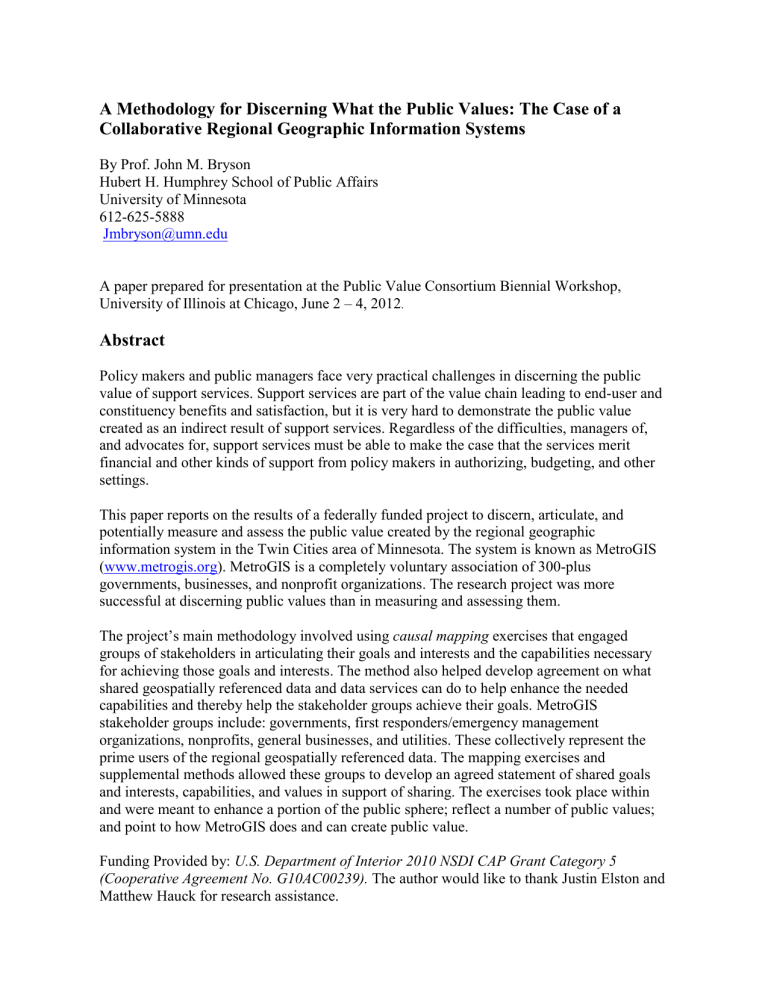
A Methodology for Discerning What the Public Values: The Case of a
Collaborative Regional Geographic Information Systems
By Prof. John M. Bryson
Hubert H. Humphrey School of Public Affairs
University of Minnesota
612-625-5888
Jmbryson@umn.edu
A paper prepared for presentation at the Public Value Consortium Biennial Workshop,
University of Illinois at Chicago, June 2 – 4, 2012
.
Abstract
Policy makers and public managers face very practical challenges in discerning the public value of support services. Support services are part of the value chain leading to end-user and constituency benefits and satisfaction, but it is very hard to demonstrate the public value created as an indirect result of support services. Regardless of the difficulties, managers of, and advocates for, support services must be able to make the case that the services merit financial and other kinds of support from policy makers in authorizing, budgeting, and other settings.
This paper reports on the results of a federally funded project to discern, articulate, and potentially measure and assess the public value created by the regional geographic information system in the Twin Cities area of Minnesota. The system is known as MetroGIS
( www.metrogis.org
). MetroGIS is a completely voluntary association of 300-plus governments, businesses, and nonprofit organizations. The research project was more successful at discerning public values than in measuring and assessing them.
The project‟s main methodology involved using causal mapping exercises that engaged groups of stakeholders in articulating their goals and interests and the capabilities necessary for achieving those goals and interests. The method also helped develop agreement on what shared geospatially referenced data and data services can do to help enhance the needed capabilities and thereby help the stakeholder groups achieve their goals. MetroGIS stakeholder groups include: governments, first responders/emergency management organizations, nonprofits, general businesses, and utilities. These collectively represent the prime users of the regional geospatially referenced data. The mapping exercises and supplemental methods allowed these groups to develop an agreed statement of shared goals and interests, capabilities, and values in support of sharing. The exercises took place within and were meant to enhance a portion of the public sphere; reflect a number of public values; and point to how MetroGIS does and can create public value.
Funding Provided by: U.S. Department of Interior 2010 NSDI CAP Grant Category 5
(Cooperative Agreement No. G10AC00239). The author would like to thank Justin Elston and
Matthew Hauck for research assistance.
John Bryson, “A Methodology for Discerning What the Public Values: The Case of a Collaborative Regional Geographic
Information Systems.”
Introduction
The academic literature includes substantial exploration of the public sphere (e.g., Dewey,
1954 (1927); Arendt, 1958; Habermas, 1971, 1973; Benington, 2011), public values (e.g.,
Bozeman, 2007; Jorgensen and Bozeman, 2007; Meynhardt, 2009; and Meynhardt and
Bartholomes, 2011), what it means to create public value (e.g., Moore, 1995; Stoker, 2006;
Benington and Moore, 2011), and the difficulties of valuation (e.g., Julnes, 2012). This paper reports on the efforts of policy makers and public managers to discern the public value created by a support service that enables and is enabled by cross-sector collaboration. Support services are part of the value chain leading to end-user and constituency benefits and satisfaction (Porter, 1998). Unfortunately, it is very hard to demonstrate the public value created as an indirect result of support services Regardless of the difficulties, managers of, and advocates for, support services must be able to make the case that the services merit financial and other kinds of support from policy makers in authorizing, budgeting, and other settings (Williams and Lewis, 2008).
Specifically, this paper reports on the results of a federally funded effort to discern, articulate, measure and assess the public value created by the regional geographic information system in the Twin Cities area of Minnesota. The system is known as MetroGIS ( www.metrogis.org
).
MetroGIS is a completely voluntary association of 300-plus governments, businesses, and nonprofit organizations. The system has won national and international awards and is widely recognized within the GIS community as one of the very best regional geographic information systems in the world. The system provides access to over 200 data sets, along with a variety of other services. For example, the system gives members virtually free access to up to dozens of attributes on almost every one of the one million-plus parcels of land in the metropolitan area.
MetroGIS is formally sponsored by the Metropolitan Council, the Twin Cities‟ regional government. The council employs and houses a small administrative staff. Governance occurs through a policy board comprised of county commissioners representing each county, a coordinating committee of data services managers from across the region, and a variety of technical advisory groups whose members are typically drawn from member organizations.
Because of the financial stringencies facing governments in particular, MetroGIS has been challenged to demonstrate the public value it creates. A federal grant helped fund development of a methodology to discern, articulate, and potentially measure and assess the public value of its services. The project‟s main methodology makes use of causal mapping exercises that engage groups of stakeholders in articulating their goals and interests and the capabilities necessary for achieving those goals and interests. The method also helps develop agreement on what shared geospatially referenced data and data services can do to help enhance the needed capabilities and thereby help the stakeholder groups achieve their goals.
Stakeholder groups involved include: governments, first responders/emergency management organizations, nonprofits, general businesses, and utilities. These collectively represent the prime users of the regional geospatially referenced data. The method allows these groups to develop an agreed statement of shared goals and interests, capabilities, and values in support of sharing. The exercises took place within and were meant to enhance a portion of the public
1
John Bryson, “A Methodology for Discerning What the Public Values: The Case of a Collaborative Regional Geographic
Information Systems.” sphere ; reflect a number of public values ; and point to how MetroGIS does and can create public value .
Methodology
The study reported on here was a part of the federally funded MetroGIS Quantify Public
Value (QPV) study, and was termed the “Defining Values” component. Through this study
MetroGIS leaders were attempting to understand the public value gained through the sharing of geospatial data, and in particular, geographically-referenced parcel data. The effort was aimed at clarifying the values that policy makers across sectors use to decide courses of action involving investments and policy.
The study involved having a dialogue via six focus groups whose members were senior managers and policy makers from differing “communities of practice” (Wenger, 1999). The first five groups represented: (1)first responders, (2) governments, (3) nonprofits, (4) public utilities, and (5) businesses. These focus groups produced materials of several kinds
(discussed below), including information related to goals or interests and capabilities. The sixth focus group gathered together the members of the previous focus groups to review materials developed as a result of those focus groups.
After each of the first five focus group sessions, the information on goals or interests and capabilities was incorporated into causal maps that were later reviewed at the final focus group session with the respective groups for accuracy and reasonableness. The sixth
(combined) focus group also reviewed for accuracy and reasonableness a map that combined the five maps from the first five focus groups. The causal maps were one of the most important products of this research.
The causal mapping method represents a significant adaptation of work previously done by
Bryson, et al. (2004), Bryson, et al. (2007), and Ackermann and Eden (2011). The purpose of causal mapping is to make sense of an area of concern by capturing and relating (structuring) the ideas that comprise it. Specifically, causal maps are statement-and-arrow diagrams (directed graphs) in which statements are linked by arrows indicating what causes (produces, results in, influences) what. In other words, the meaning of any particular idea consists of its context – that is, the ideas that influence it ("arrows in") and the ideas that flow from it as consequences or outcomes ("arrows out"). Chains of arrows ( A
B
C ) visibly indicate lines of argumentation (Simons, 2001) that enable groups to engage in deliberative argumentation aimed at clarification, understanding, agreement, and often commitment and action (Roberts, 2002;
Barzelay and Thompson, 2010). As ideas are explored, different interpretations are identified, leading to a more complete picture. Comparing and contrasting ideas and elaborating their connections helps establish a rich context that makes understanding both possible and easier
(Kelly, 1963; Weick, 1995).
Overview of Individual Focus Group Process
As noted, the study six focus groups. Five focus groups – each targeting a different community of practice – were held between October 14 and November 30, 2011. These will be termed “individual focus groups.” The final focus group event – the “combined focus
2
John Bryson, “A Methodology for Discerning What the Public Values: The Case of a Collaborative Regional Geographic
Information Systems.” group” – was held on December 1, 2011, and brought together participants from each of the prior focus groups to explore, as a large group, shared values and beliefs about the benefits of sharing. The five communities of practice groups were as follows. They were held in the order listed:
First Responders
Governments
Non-Profits
Public Utilities
Businesses
For each of the sessions, Randall Johnson, MetroGIS Staff Coordinator, and Professor John
Bryson, the Defining Values Study researcher and facilitator, welcomed the participants, thanked them for agreeing to participate in the event, and briefly explained that their focus group was one of several through which MetroGIS hoped to define values and business drivers common to these communities of practice (or interest). (A research assistant, either
Justin Elston or Matthew Hauck, also attended each session.)
The participants sat at tables that were arranged in a semi-circle facing a wall on which several white flip chart pages were taped – four to six across in two rows. John Bryson handed out a worksheet to each participant prior to each of the four major segments that comprised each event (sample invitation letters and agendas are available from the author).
The four worksheets focused on:
Goals or interests and capabilities
Values and perceived public values
Ways in which achievement of the goals or interests depended on data, the consolidation and coordination of data, and spatial, graphic, or visual information systems
Value of sharing data, other kinds of resources, and work
The participants were asked to brainstorm for about five minutes on possible responses to the questions on a particular worksheet. Each participant was then asked to select his or her best responses and write each one on a separate large post-it note. Bryson then facilitated a conversation with the group about how best to cluster the ideas according to common themes or subject matter, while also arranging them on the large papered wall space in front of the semi-circle of participants. Once the group agreed on clusters, the next task involved having the group offer a summary label for each cluster of related ideas. This process was repeated for each of the four main segments of the event outlined above. For the “values” segments, the participants were also asked to individually vote using red and green sticky dots – red for values that matter most to the community of practice and green for values that they perceived to matter most to the public. A recap of the information gathered during each of the five individual focus groups is provided following the general findings presented below.
After each of the first five sessions a causal map was produced that linked goals or interests and capabilities (see Figures 3 – 7, which are discussed after the next section). These maps were then reviewed for accuracy and reasonableness at the final focus group session by the respective individual focus groups. The five individual focus group maps were also combined and presented to the combined focus group for its review for accuracy and reasonableness
3
John Bryson, “A Methodology for Discerning What the Public Values: The Case of a Collaborative Regional Geographic
Information Systems.”
(see Figure 8, also discussed after the next section). The combined map was used to pool individual and combined focus group judgments regarding what focus group participants believed the public most values and also what the communities of practice most value (see
Figures 1 and 2 in the next section).
Overview of Combined Group Process
The combined group followed a different process. The maps from the first five focus groups were combined into a group map, which was presented to the combined focus group, with each community of practice seated at a separate table. Each community of practice group was asked if they wished to claim any of the goals or interests and capabilities that had been identified by the other focus groups as their own. Groups then shared with the other groups the results of this exercise. It turned out that each of the communities of practice shared at least some goals and interests with at least two other focus groups. In addition, in all cases but one, each focus group shared at least some capabilities with at least two other focus groups.
The degree of overlap in goals or interests and capabilities across communities of practice is thus quite substantial. Focus group participants were then asked – using a colored stick-on dot process – to indicate which goals and capabilities they thought the public most valued, and which goals and capabilities the communities of practice most valued. See Figure 1 for what participants though the public most valued and Figure 2 for what they thought the communities of practice most valued.
In addition, after the previous focus group sessions, the researcher combined into a single list the reasons the groups gave for the benefits of sharing data and information, other kinds of resources, and work. These results were recorded in three Word tables which were then each blown up to flipchart size. The combined group reviewed these pooled results and voted
(using colored stick-on dots) on what they thought the most important reasons were for sharing in each of these categories. Again, there was substantial agreement across focus groups regarding the main reasons for sharing.
General Findings – Combined Focus Group
In this section we report on the general findings from the combined focus group meeting. Five key findings are presented. These are what the combined group:
Believes the public values in terms of goals and interests
Believes the public values in terms of capabilities
Sees as the benefits of sharing data and information
Sees as the benefits of sharing other kinds of resources
Sees as the benefits of sharing work
The combined focus group believes the public most values the following items (see Table 1 and Figure 1):
Providing reliable service at reasonable cost
Ensuring public safety
Providing effective, efficient, quality services
Ensuring better decision making for public and private benefit
4
John Bryson, “A Methodology for Discerning What the Public Values: The Case of a Collaborative Regional Geographic
Information Systems.”
Improving the quality of life
Helping develop a stronger local economy
Ensuring physical infrastructure is developed and maintained
Preserving life and safety
“Making the case” for public and nonprofit services
Transitioning to recovery (in the case of disaster)
Building community capacity in terms of place and interest.
5
John Bryson, “A Methodology for Discerning What the Public Values: The Case of a Collaborative Regional Geographic
Information Systems.”
Table 1. Combined Focus Group – Perceptions of What the Group Believe the Public
Values in Terms of Goals and Interests
18
16
14
12
10
8
6
4
2
0
Combined Focus Group -- Perceptions of What the Group Believes the Public Values in Terms of
Goals and Interests
In terms of capabilities needed to achieve the goals and pursue the interests listed above , the combined focus group believes the public most values the following items (see Table 2 and
Figure 1):
Understanding needs and expectations of citizens
Responding by leading and adapting to any situation
Effective executive leadership
Communicating and interacting effectively
Accurate data
Effective implementation and action (“Do”)
Ease of access to information
6
John Bryson, “A Methodology for Discerning What the Public Values: The Case of a Collaborative Regional Geographic
Information Systems.”
Table 2. Combined Focus Group – Perceptions of What the Group Believe the
Capabilities That Are Necessary to Achieve the Public’s Goals and Interests
Combined Focus Group -- Perceptions of Public
Priorities Regarding Necessary Capabilities
3
2
1
0
5
4
7
6
Figure 1 on the next page shows how the researcher believes these goals and capabilities are linked. The arrows in the figure mean “may lead to” or “might result in.” In other words,
“Improving quality of life” (Statement 21) at the top of the map may viewed as a direct consequence of “Stronger local economy” (48), “Ensure public safety; preserve life and safety” (35), and “Better decision making/private and public” (56); and as an indirect consequence of all the hother statements on the map. Note that the code after each statement identifies the origin of the original statements as follows: FR = First Responders, G =
Government, NP = Nonprofits, U = Public Utilities, and B = Business; G or I = Goal or
Interest and C = Capability. The map therefore represents visually how the separate focus groups took into account what other groups thought when developing a shared view of what the combined groups believe the public wants.
1
1
Note that if the results are rotated clockwise 90 degrees they may be thought of as a logic model indicating how capabilities might be drawn upon to produce desired outcomes, that is, achieve goals or serve interests.
7
John Bryson, “A Methodology for Discerning What the Public Values: The Case of a Collaborative Regional Geographic
Information Systems.”
A crucial feature of this map from the standpoint of the Defining Values Study is that
“Ease of access to information” (36), “Accurate data” (38), and “Executive leadership”
(14) are the starting points for the chains of logic leading to “Improve quality of life”
(21). All lines of arguments lead from those starting points.
A caution, however, is in order. The map was constructed by the researcher, not by the combined focus group members, although it was reviewed by them for accuracy and reasonableness. It therefore is important not to read too much into the map or to place much emphasis on comparing and contrasting the different groups‟ contributions to this figure, particularly given the small numbers of participants from each of the five community or practice groups represented in the combined focus group. Indeed, the researcher is uncomfortable going any further than he has. An important next step would be to verify the face validity of Figure 1 with a larger group(s) of stakeholders.
8
John Bryson, “A Methodology for Discerning What the Public Values: The Case of a Collaborative Regional Geographic
Information Systems.”
9
John Bryson, “A Methodology for Discerning What the Public Values: The Case of a Collaborative Regional Geographic
Information Systems.”
Regarding the benefits of sharing, the combined focus groups believe that the following are the major benefits of sharing data and information (see Table 3):
Better decision making
Accuracy
Data accessibility and availability
Cost saving and cost sharing
Timely data
Improved data standards
Table 3. Combined Focus Group – Perceptions of What the Group Believes Are the
Most Important Values to Be Served by Sharing Data and Information
16
14
12
10
8
6
4
2
0
Combined Focus Groups -- Perceived Value of
Sharing Data and Information
The combined focus group believes the following represent the major value to be gained by sharing other resources (see Table 4):
Greater connectivity, collaboration, and alignment
Cost savings and cost effectiveness
Flexibility to do other things, one of which is to innovate
Improved data accuracy
Increased impact
10
John Bryson, “A Methodology for Discerning What the Public Values: The Case of a Collaborative Regional Geographic
Information Systems.”
Increased organizational and project viability
11
John Bryson, “A Methodology for Discerning What the Public Values: The Case of a Collaborative Regional Geographic
Information Systems.”
Table 4. Combined Focus Group – Perceived Benefits of Sharing Other Resources
Combined Focus Groups -- Perceived Value of
Sharing Other Resources
14
12
10
8
6
4
2
0
The combined focus group believes the following represent the major value to be gained by sharing work (see Table 5):
Better decision-making
Cost efficiency and cost effectiveness
Better products and services
Better understanding, planning, governance, and attractiveness to businesses
Innovation as a result of sharing
Finding and sharing best practices
Facilitation of policy-based discussions
12
John Bryson, “A Methodology for Discerning What the Public Values: The Case of a Collaborative Regional Geographic
Information Systems.”
Table 5. Combined Focus Group – Perceived Benefits of Sharing Work
Combined Focus Group -- Perceived Value of
Sharing Work
10
9
8
7
6
5
4
3
2
1
0
More Specific Findings - Combined Focus Group Session
The more specific findings from the combined focus group session are those that relate to the five individual focus groups represented at the final session. We began by presenting two tables that summarize across the individual focus groups what the focus groups themselves value – as opposed to what they believe the public values.
In the case of the goals and interests , what the five individual focus groups as a set value for themselves, shows more dispersal in valuations than was the case with what the combined focus group thought the public values. Table 6 shows the array of what the focus groups value for themselves (see Figure 2). The top four values are:
Better decision making for public and private benefit
Achieving and maintaining accurate maps and data
Ensuring public safety
Accessing data efficiently
13
John Bryson, “A Methodology for Discerning What the Public Values: The Case of a Collaborative Regional Geographic Information Systems.”
Table 6. A Summary of the Goals and Interests of the Five Individual Focus Groups
Summary of the Goals and Interests of the Five Individual Focus Groups
14
12
10
8
6
4
2
0
14
The capabilities the five individual focus groups as a set value for themselves – as opposed to what they think the public values – are easier to summarize (see
Table 7 and Figure 2 Attachment 30). The groups as a set value:
Getting easy data accessibility
Accurate data
Collaboration and coordination in achievement of goals and program implementation
Responsiveness – leading and adapting to any situation
Understanding the needs and expectations of citizens
Obtaining information for planning and implementation
Communicating interactively effectively
Ensuring a sustainable organization
Researching and implementing best practices
Executive leadership
Good working relationships with counties and utilities
Ease of access to information
Table 7. A Summary of the Capabilities the Five Individual Focus Groups
Believe Are Necessary to Achieve Their Own Goals and Interests
8
7
6
5
4
3
2
1
0
Summary of the Capabilities the Five Individual
Focus Groups Believe Are Necessary to Achieve
Their Own Goals and Interests
15
Figure 2 on the next page shows how the researcher believes these goals and capabilities are linked. The arrows in the figure mean “may lead to” or “might result in.” In other words, “Serve the Public” (Statement 44) at the top of the map may viewed as a direct consequence of “Better decision making/private and public (56) and “Build community capacity; [communities of] place and interest”
(22), and as an indirect consequence of all the other statements on the map. Note that the code after each statement identifies the origin of the original statements as follows: FR = First Responders, G = Government, NP = Nonprofits, U = Public
Utilities, and B = Business; G or I = Goal or Interest and C = Capability. The map therefore represents visually how the separate focus groups took into account what other groups thought when developing a combined of what the groups want for themselves.
2
A crucial feature of this map from the standpoint of the Defining Values
Study is that “Accurate data” (38), “Access data efficiently” (51) and “Get easy data accessibility – One Stop Shop; Ease of access to information” (57) are the starting points for the chains of logic leading to “Serve the Public ”
(44). All lines of arguments lead from those starting points. However, the same caution is in order as with Figure 1. The map was constructed by the researcher, not by the combined focus group, although the map was reviewed by the focus group for accuracy and reasonableness. It therefore is important not to read too much into the map or to place much emphasis on comparing and contrasting the different groups‟ contributions to this figure, particularly given the small numbers of participants from each of the five community or practice groups represented in the combined focus group. Indeed, the researcher is uncomfortable going any further than he has. An important next step would be to verify the face validity of Figure 2 with a larger group(s) of stakeholders.
2
Again, note that the results may be thought of as a logic model indicating how capabilities might be drawn upon to produce desired outcomes, that is, achieve goals or serve interests.
16
17
Membership on, and a Brief Summary of, Results from the Six Focus Groups
In this section we present summary results from the five individual focus groups. We present the results in the order in which the focus groups met. The results for each focus group include a map indicating how the researcher believes the goals and interests and capabilities the group most values are linked. Sometimes the maps contain statements originally suggested by other focus groups when the connection appears to be quite logical
1.
First Responder Focus Group, Minnesota Counties Insurance Trust (MCIT) Building,
October 14, 2011
Participants
Barry
Altman
Gordon
Chinander
Hart
Gilchrist
General
Joe Kelly
Sean
Mangan
Fire Chief
Ulie Seal
Chris
Terzich,
Red Cross
Metropolitan Emergency Services
Board (MESB)
Roseville Fire
Deputy Director, HSEM
Pipeline Safety
City of Bloomington
InfraGard (disaster response point person for Wells Fargo
Support Present:
Professor John Bryson, Humphrey School of Public Affairs, U of Mn ( Facilitator )
Matthew Hauck, Humphrey School of Public Affairs, U o f Mn ( Research Assistant )
Randall Johnson, MetroGIS Staff Coordinator and QPV Study Coordinator
Summary of Key Results
The following is a summary of the major findings from each of these activities for the First
Responder community.
Goals or Interests
Goals coalesce around protecting individuals and understanding the contexts and causalities of threat scenarios.
Goals or Interests - First Responder Values and Perceived Public Values
18
Priorities overlap somewhat around “Stabilize the situation” and “Preserve life and safety”, but are otherwise scattered between a variety of other values.
Capabilities
There is an emphasis on adaptability and strong communication of ideas and plans.
Data and Information Dependencies
Having access to accurate, specific data elements, which can be easily accessed and shared, is key.
Value of Sharing Data
The value of sharing centers on the ability to quickly respond and apply resources in an efficient way.
The First Responders’ Concept Map
The First Responders‟ map is presented in Figure 3. As might be expected, “Preserve life and safety” (4) is the ultimate goal. (Bolded concepts are ones that also show up in Figure 2.)
19
20
1.
Government Focus Group, Minnesota Counties Insurance Trust (MCIT) Building,
November 9, 2011
Participants
Cliff
Aichinger
Terry
Schneider
Victoria
Reinhardt
Guy
Peterson
Nancy
Read
Mary
Emerson
Jesse
Pearson
Support Present:
Ramsey Washington Metro
Watershed District
City of Minnetonka
Ramsey County
Metropolitan Council
Metropolitan Mosquito Control
District (MMCD)
MN Dept Human Services
MnDOT
Professor John Bryson, Humphrey School of Public Affairs, U of MN ( Facilitator )
Justin Elston, Research researcher
Randall Johnson, MetroGIS Staff Coordinator and QPV Study Coordinator
Janie Norton, MetroGIS Project Manager (Observer)
Summary of Key Results
The following is a summary of the major findings from each of these activities for the
Government community.
Goals or Interests
Goals indicate a strong focus on providing public services, as well as ensuring that those services match with the public‟s expectations.
Goals or Interests – Policy-maker Values and Perceived Public Values
There is a perception of significant overlap between constituent and policy maker values, with the exception of the policy maker value of ensuring sustainable vision and goals.
Capabilities
21
Capabilities indicate an emphasis on connecting with constituents and coordinating efforts with other agencies and organizations.
Data and Information Dependencies
Members indicate a perception of data as a tool to better understand the world within which the organization exists.
Value of Sharing Data
Results indicate a focus on data as a tool to create efficiency across all resources.
Government Officials’ Concept Map
The Government Officials map is presented in Figure 4. The ultimate goal for this group was
“Meet the needs of constituents” (10). (Bolded concepts are ones that also show up in Figure
2.)
22
23
2.
Nonprofit Focus Group
Hubert H. Humphrey School of Public Affairs, November 11, 2011
Participants
Chad
Dipman
Dan
Hylton
Jeff
Narabrook
Linden
Weisnerda
Mike
Pease
Sally
Wakefield
Twin Cities Habitat for Humanity
HousingLink
Council of Non-Profits
Trust for Public Land
Embrace Open Space
Envision MN
Support Present:
Professor John Bryson, Humphrey School of Public Affairs, U of Mn ( Facilitator )
Justin Elston, Research researcher
Randall Johnson, MetroGIS Staff Coordinator and QPV Study Coordinator.
Summary of Key Results
The following is a summary of the major findings from each of these activities for the First
Responder community.
Goals or Interests
Priorities indicate a focus on building connections between different groups, and supporting positive change.
Goals or Interests - Nonprofit Values and Perceived Public Values
There is a perception of less overlap between the public‟s priorities and the nonprofit sector‟s priorities, except for the goal of “Improve quality of life”.
Capabilities
A wide variety of different capabilities are indicated, broadly encompassing selfimprovement, hard work and influencing others.
24
Data and Information Dependencies
Data are viewed primarily as an avenue for better evaluation of issues.
Value of Sharing Data
Data allows for better coordination between groups, and around strategic goals.
Nonprofit Officials Concept Map
The Nonprofit Officials map is presented in Figure 5. The ultimate goal for this group was
“Improve quality of life” (21). (Bolded concepts are ones that also show up in Figure 2.)
25
26
3.
Utility Focus Group
Minnesota Counties Insurance Trust (MCIT) Building, November 16, 2011
Participants
Allan
Radke
Jay
Bennett
Ryan
Babler
Xcel Energy
CenterPoint Energy
Korpartners (GopherOneCall contractor)
Support Present:
Professor John Bryson, Humphrey School of Public Affairs, U of Mn ( Facilitator )
Randall Johnson, MetroGIS Staff Coordinator and QPV Study Coordinator.
Summary of Key Results
The following is a summary of the major findings from each of these activities for the First
Responder community.
Goals or Interests
Utilities are focused on operational goals, centered on day-to-day indices.
Goals or Interests - Utility Values and Perceived Public Values
Notable overlap exists between the Goals or Interests of utilities, and the perceived preferences of the public, with the exception of Making a Profit and Achieve and Maintain accurate maps and data.
Capabilities
There is an emphasis on the utility of data in the ongoing operations of utilities.
Data and Information Dependencies
Responses indicate a view of data as instrumental in building relationships & delivering good customer service.
Value of Sharing Data
27
Sharing helps promote more effective service delivery, planning and communication.
Utilities Officials’ Concept Map
The Utilities Officials‟ map is presented in Figure 6. The ultimate goals for this group were
“Meet needs of constituents” (10), “Make a profit” (33), and “Provide reliable service at a reasonable price” (34). (Bolded concepts are ones that also show up in Figure 2.)
28
29
4.
Business Focus Group
Hubert H. Humphrey School of Public Affairs, November 30, 2011
Participants
Adam
Fisher
John
Carpenter
Cathy
Capone
Bennett
Curt
Carlson
Jeff
Budish
Support Present:
MnCar
Excensus
researcher to Urban Land Institute
MLS
CB Richard Ellis
Professor John Bryson, Humphrey School of Public Affairs, U of Mn ( Facilitator )
Randall Johnson, MetroGIS Staff Coordinator and QPV Study Coordinator
Justin Elston, Research researcher
Summary of Key Results
The following is a summary of the major findings from each of these activities for the First
Responder community.
Goals or Interests
Goals and interests center on leveraging data for business purposes, which then has favorable consequences in terms of better decision making for private and public benefit, meeting client needs, generating revenue, and ultimately serving the public. The concern for the public broadly conceived was a noteworthy feature of this group.
Capabilities
The group emphasized on need to have easy data accessibility via a “one stop shop.”
Data and Information Dependencies
The group did not address this question.
Value of Sharing Data
30
The group emphasized that sharing data and information could produce time and cost saving and higher data quality via more scrutiny. The sharing of resources was thought to enhance cost savings, organizational comparative advantages, and the perceived sophistication of the region. Sharing work was thought to lead to better results in a variety of ways, including better governance and improved attractiveness of the region for businesses and other.
Business Officials’ Concept Map
The Business Officials‟ map is presented in Figuren7. The ultimate goal is “Serve the Public”
(44) via “Better decision making / private and public benefit” (56) and “Generating revenue”
(45). (Bolded concepts are ones that also show up in Figure 2.)
31
32
5.
Combined Focus Group
Metropolitan Counties Government Center, December 1, 2011
Participants
Barry
Altman
General
Joe Kelly
Terry
Schneider
Guy
Peterson
Nancy
Read
Jesse
Pearson
Chad
Dipman
Dan
Hylton
Sally
Wakefield
Allan
Radke
Jay
Bennett
Ryan
Babler
Adam
Fisher
John
Carpenter
Cathy
Capone
Bennett
Red Cross
Deputy Director, HSEM
City of Minnetonka
Metropolitan Council
Regional – MMCD
MnDOT
Twin Cities Habitat for Humanity
HousingLink
Envision MN
Xcel Energy
CenterPoint Energy
Korpartners (GopherOneCall contractor)
MnCar
Excensus
Urban Land Institute
Support Present:
Professor John Bryson, Humphrey School of Public Affairs, U of Mn ( Facilitator )
Randall Johnson, MetroGIS Staff Coordinator and QPV Study Coordinator.
Justin Elston, Research researcher
Summary of Key Results
33
The combined focus group believes the public most values the following goals and interests :
Providing reliable service at reasonable cost
Ensuring public safety
Providing effective, efficient, quality services
Ensuring better decision making for public and private benefit
Improving the quality of life
Helping develop a stronger local economy
Ensuring physical infrastructure is developed and maintained
In terms of capabilities needed to achieve the goals and pursue the interests listed above, the combined focus group believes the public most values the following items:
Understanding needs and expectations of citizens
Responding by leading and adapting to any situation
Effective executive leadership
Communicating and interacting effectively
Accurate data
Effective implementation and action (“Do”)
Ease of access to information
The more specific findings of the final focus group session are those that relate to the individual community of practice focus groups. In the case of goals and interests, what the five individual focus groups as a set value for themselves shows more dispersal in valuations than was the case with what the combined focus group thought the public values. The top four goals and interests the focus groups value for themselves – as opposed to what they think the public values – are:
Better decision making for public and private benefit
Achieving and maintaining accurate maps and data
Ensuring public safety
Accessing data efficiently
The top capabilities the five individual focus groups as a set value for themselves – as
opposed to what they think the public values – are:
Getting easy data accessibility
Accurate data
Collaboration and coordination in achievement of goals and program implementation
Responsiveness – leading and adapting to any situation
Understanding the needs and expectations of citizens
Communicating interactively effectively
Obtaining information for planning and implementation
The combined focus groups believe that the following are the major benefits of sharing data and information :
Better decision making
Accuracy
Data accessibility and availability
Cost saving and cost sharing
34
Timely data
Improved data standards
The combined focus group believes the following represent the major values to be gained by sharing other resources :
Greater connectivity, collaboration, and alignment
Cost savings and cost effectiveness
Flexibility to do other things, one of which is to innovate
Improved data accuracy
Increased impact
Increased organizational and project viability
The combined focus group believes the following represent the major values to be gained by sharing work :
Better decision-making
Cost efficiency and cost effectiveness
Better products and services
Better understanding, planning, governance, and attractiveness to businesses
Innovation as a result of sharing
Finding and sharing best practices
Facilitation of policy-based discussions
Final Focus Group’s Starting and Final Concept Maps
The final focus group began its work by assessing the composite map presented in Figure 8 that merges the concepts maps for the five individual focus groups (Figure 3 – 7). The links that are bolded and without arrows indicate strong affinities among concepts across focus groups. Figure 1 and 2 (pp. 9 and 16) summarize the results of the combined focus group‟s work in which areas of strong agreement on goals and capabilities are featured.
35
36
Conclusions
There appears to be a substantial overlap across focus groups in goals and interests and capabilities seen as important for facilitating achievement of the goals and interests. The overlap conceivably could be a result of two kinds of selection bias in formation of the focus groups. Those who were invited may have had a predisposition to favor sharing of data and information, other resources, and work, and may have been favorably disposed toward a geospatial data and application commons. That said, the results were produced via thoughtful deliberations within each focus group and at the final combined focus group meeting. And, perhaps most importantly, the results certainly appear to be reasonable.
There appears to be substantial agreement on the benefits of sharing data and information, other resources, and work. There was no real surprise in finding that the government, nonprofit, and first responder communities saw that sharing – including across sectors – of data and information, other resources, and work carried with it many benefits.
What was surprising, at least to the researcher, was how much support there appears to be in the business community (including utilities) for pursuing sharing of data and information, other resources, and work across sectors. The business community focus group went even further by emphasizing the importance of an enhanced geospatial data commons as a vital way for helping businesses achieve their goals and pursue their interests. The fact that the business community includes among the goals it would claim many goals shared by other sectors strengthens the case for sharing across communities of practice via a geospatial data and applications commons.
The method used in this study to discern goals, interests, desired capabilities, and the value of sharing provides a way forward in the effort to quantify public value. The method helped improve clarity about what the stakeholders value as separate communities of practice and what they believe the public values. The method represents a way of pooling subjective judgments about what is of public value (Meyhnardt, 2009, p. 212), which is both a strength and a weakness. The method also points to areas of potential public and market success and failure (Bozeman, 2007). The direct link to practice is probably its greatest strength; the absence of a strong theoretical base is its greatest weakness.
Important future studies might begin by having the following objectives:
Test for agreement on the lists of goals or interests, capabilities, and reasons for sharing that the focus groups in this study developed by engaging larger, more completely representative focus groups in each of the community of practice areas to.
Verify the face validity of the concept maps produced as part of this research (Figure 1 –
7). These maps represent potential logic models showing how data-related capabilities are linked to goal achievement and therefore provide a kind of core logic underpinning creation, development, and maintenance of a geospatial data commons. The assessment of the validity of the maps might include a study in which focus group members engage as individuals in a systematic paired-comparisons exercise to determine which statements lead to other statements.
Develop measures that capture the important dimensions of the shared goals, interests, capabilities, and benefits of sharing. There is a need to develop suitable measures in the categories identified via the focus group research. These measure could be of assistance in doing the following:
37
Determine whether or not MetroGIS is helping – probably indirectly – the constituent communities of practice achieve their goals and interests, maintain or develop the capabilities they need to achieve their goals and interests, and realize the benefits of sharing data and information, other resources, and work.
Find ways to improve the method without losing is pragmatic strengths by linking it directly to stronger theoretical bases, such as those found in the work of Bozeman (2007) and Meynhardt and his colleagues (Meynhardt, 2009; Meynhardt and Bartholomes, 2009).
While the approach to discerning public and community of practice values is in many ways quite crude, the MetroGIS Policy Board did find the results promising enough to do two things.
First, they have authorized further study of the approach and its usefulness as part of their FY 2013 budget. Second, they are using the results to fine-tune their existing strategies and to consider development of new strategies that build on the values identified in order to create more public value for the public generally and for key stakeholder groups.
References
Ackermann, F., and C. Eden (2011) Making Strategy: Mapping Out Strategic Success .
Thousand Oaks, CA: SAGE.
Arendt, H. (1958) The Human Condition. Chicago, IL: University of Chicago Press.
Barzelay, M., and F. Thompson (2010) “Making Public Administration a Design Science,”
Public Administration Review, Supplement to Volume 70, p. S295 .
Benington, J. and M. Moore (2011) Public Value: Theory and Practice. New York: Palgrave.
Bozeman, B. (2007) Public Value and Public Interest: Counterbalancing Economic
Individualism. Washinton, DC: Georgetown University Press.
Jorgensen, T. & Bozeman, B. (2007) “Public Values: An Inventory.” Administration Society ,
39(3), 354-381.
Bryson, J., F. Ackermann, C. Eden, and C. Finn (2004) Visible Thinking: Unlocking Causal
Mapping for Practical Business Results . Chichester, England: John Wiley.
Bryson, J., F. Ackermann, and C. Eden (2007) “Putting the Resource-Based View of Strategy and Distinctive Competencies to Work in Public Organizations.” Public Administration
Revie w, 67(4), 702 – 717.
Dewey, J. (1954 [1927]) The Public and Its Problems. Athens, OH: Ohio University/Swallow
Press.
Habermas, J (1971) Knowledge and Human Interests. Boston, MA: Beacon Press.
Habermas, J. (1973) Legitimation Crisis. Boston, MA: Beacon Press.
38
Julnes, G. Julnes, G. (2012). “Developing policies to support valuing in the public interest.” .
New Directions for Evaluation, 133, 109–129.
Meynhardt, T. 2009. „„Public Value Inside: What Is Public Value Creation?‟‟
International
Journal of Public Administration , 32(3): 192–219.
Meynhardt, T., and S. Bartholomes (2011) “(De)Composing Public Value: In Search of Basic
Dimensions and Common Ground, International Public Management Journal ,” 14(3),
Moore, M. (1995) Creating Public Value. Cambridge, MA: Harvard University Press.
Porter, M. (1998) Competitive Advantage . New York: Free Press.
Roberts, N. (ed.) (2002) The Transformative Power of Dialogue. Oxford, England: Elsevier.
Stoker, G. (2006) “Public Value Management: A New Narrative for Networked
Governance?”
American Review of Public Administration, 36(1), 41 – 57.
Williams and Duncan Lewis (2008) “Strategic Management Tools and Public Sector
Management: The Challenge of Context Specificity,” Public Management Review , 10(5), 653
– 671.
39
